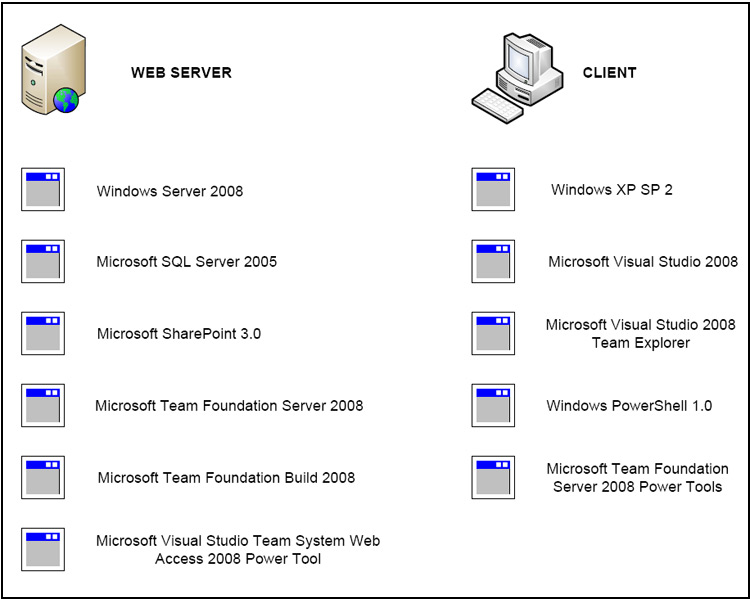|
|
|
Looking For Team Architect 2008 Tutorials? Go here.
Looking For TFS 2008/SQL Server Scripting? Go here.
Looking For TFS 2008 Deleting A Team Project? Go here.
|
Purpose
The purpose of this project is to become familiar with Team Foundation Server 2008 by providing an overview of an example server and client setup, tips ("Extra Tweeks For Team Foundation Server" below), and a series of tutorials ("Team Foundation Server 2008 Tutorials" below) for completing common tasks.
Overview
There are several different ways that a web server (or servers) may be setup to work with Team Foundation Server. Figure 1 illustrates one example setup:

Figure 1: Example Server/Client TFS Configuration
Team Foundation Server 2008 Tutorials
A series of step by step tutorials have been put together to demonstrate some of the ways common features may be used. The tutorials have been further sub-divided into two groups based on common needs of management and developers.
Management Oriented Tasks
Developer Oriented Tasks
Extra Tweaks For Team Foundation Server
After Team Foundation Server 2008 has been installed on a Microsoft 2005 Web Server (which already has Sharepoint installed), TFS Power Tools can be installed:
http://www.microsoft.com/downloads/details.aspx?FamilyID=00803636-1D16-4DF1-8A3D-EF1AD4F4BBAB&displaylang=en
However, you may need to have Windows PowerShell 1.0 already installed, which requires the .Net Framework 2.0:
http://www.microsoft.com/windowsserver2003/technologies/management/powershell/download.mspx
If you wish to provide a web method for TFS and to send alerts via email, you will need to install the "Visual Studio Team System Web Access 2008 Power Tool" on the TFS Server:
http://www.microsoft.com/downloads/details.aspx?FamilyID=c568fba9-3a62-4781-83c6-fdfe79750207&displaylang=en
Then you will need to configure SMTP for the TFS Server (\Program Files\Microsoft Visual Studio 2008 Team Foundation Server\Web Services\Services\Web.config) for alerts similiar to:
<appSettings>
<add key="ConnectionString" value="Application Name=TeamFoundation;Persist Security Info=False;Initial Catalog=TfsIntegration;Data Source=TFS2008;Integrated Security=SSPI"/>
<add key="eventingEnabled" value="true" />
<add key="DetailedExceptions" value="false" />
<add key="emailNotificationFromAddress" value="webmaster@your-site.com" />
<add key="smtpServer" value="emailserver.your-site.com" />
</appSettings>
Finally, to set up the web access for SMTP go to \Program Files\Microsoft Visual Studio 2008 Team System Web Access\Web\Web.config on the TFS Server similiar to:
<webAccessSettings>
<emailSettings sendingEmailEnabled="true" />
</webAccessSettings>
<system.net>
<mailSettings>
<smtp deliveryMethod="network" from="webmaster@your-site.com"></smtp>
</mailSettings>
</system.net>
Another Tweak: Visual Studio 2008 Web Deployment Projects
If you need to be able to control and customize pre-build or post-build activities done with Visual Studio 2008 you will want this Tool:
http://www.microsoft.com/downloads/details.aspx?FamilyId=0AA30AE8-C73B-4BDD-BB1B-FE697256C459&displaylang=en
Rare Maintenance: Get Team Foundation Server 2008 Power Tools
On some rare occasions you may need to find out the workspace (commonly the computer name) of a TFS user. This can be done by logging into the TFS server and opening (via command-prompt after navigating to the folder):
C:\Program Files\Microsoft Team Foundation Server 2008 Power Tools\TfsServerManager.exe
You will need to point to the TFS server. Once the TFS server appears in the list you can double-click on the name to bring up another pane. Within that pane you'll see a variety of tabs. Click on the maintenance tab which will show you all of the users who've been involved with TFS along with workspace names.
On other occasions you may need to remove a "exclusive lock" on one or more files in a project or cancel pending changes. You'll need to know the user, the project name, and workspace. Then, after navigating to the folder in the path below on the TFS server, open the command-prompt and enter:
Path: C:\Program Files\Microsoft Visual Studio 9.0\Common7\IDE\TF.exe
Command to Enter: tf undo /workspace:COMPUTERNAME202;username /recursive $/Folder1/Folder2/Project /s:http://tfs:8080
NOTES:
"COMPUTERNAME202" may be the name of the computer the project was on or a workspace name.
"username" is the username of the user.
"$/Folder1/Folder2/Project" is the TFS path to the project.
"http://tfs:8080" is the URL to the TFS server.
